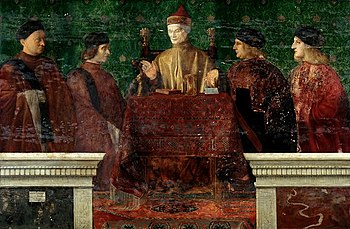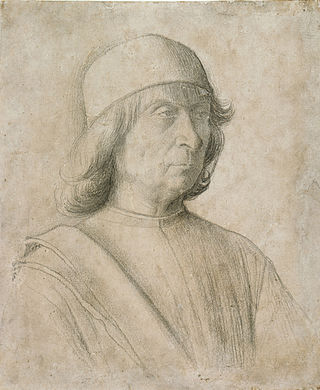
Gentile Bellini was an Italian painter of the school of Venice. He came from Venice's leading family of painters, and at least in the early part of his career was more highly regarded than his younger brother Giovanni Bellini, the reverse of the case today. From 1474 he was the official portrait artist for the Doges of Venice, and as well as his portraits he painted a number of very large subjects with multitudes of figures, especially for the Scuole Grandi of Venice, wealthy confraternities that were very important in Venetian patrician social life.

The Basilica dei Santi Giovanni e Paolo, known in Venetian as San Zanipolo, is a church in the Castello sestiere of Venice, Italy.

Vittore Carpaccio (UK: /kɑːrˈpætʃ oʊ/, US: /-ˈpɑːtʃ-/, Italian: [vitˈtoːre karˈpattʃo]; was an Italian painter of the Venetian school who studied under Gentile Bellini. Carpaccio was largely influenced by the style of the early Italian Renaissance painter Antonello da Messina, as well as Early Netherlandish painting. Although often compared to his mentor Gentile Bellini, Vittore Carpaccio's command of perspective, precise attention to architectural detail, themes of death, and use of bold color differentiated him from other Italian Renaissance artists. Many of his works display the religious themes and cross-cultural elements of art at the time; his portrayal of St. Augustine in His Study from 1502, reflects the popularity of collecting "exotic" and highly desired objects from different cultures.

Leonardo Loredan was a Venetian nobleman and statesman who reigned as the 75th Doge of Venice from 1501 until his death in 1521. As a wartime ruler, he was one of the most important doges in the history of Venice. In the dramatic events of the early 16th century, Loredan's Machiavellian plots and cunning political manoeuvres against the League of Cambrai, the Ottomans, the Mamluks, the Pope, the Republic of Genoa, the Holy Roman Empire, the French, the Egyptians and the Portuguese saved Venice from downfall.
Events from the year 1501 in art.

The Portrait of Doge Leonardo Loredan is a painting by Italian Renaissance master Giovanni Bellini, dating from c. 1501–02. It portrays Leonardo Loredan, the Doge of Venice from 1501 to 1521, in his ceremonial garments with the corno ducale worn over a linen cap, and is signed IOANNES BELLINVS on a cartellino. It is on display in the National Gallery in London.

The House of Vendramin was a rich merchant family of Venice, Italy, who were among the case nuove or "new houses" who joined the patrician class when the Libro d'Oro was opened after the battle of Chioggia. Andrea Vendramin served as the sole Vendramin Doge from 1476–78, at the height of Venetian power, though in 1477 an Antonio Feleto was imprisoned, then banished, for remarking in public that the Council of the Forty-One must have been hard-pressed to elect a cheesemonger Doge. In his youth, Andrea and his brother Luca, in joint ventures, used to ship from Alexandria enough goods to fill a galley or a galley and a half, Malipiero recorded in retrospect: even his factors grew rich managing his affairs. At this period, mentions of Vendramins in various fields of business occur; Luca Vendramin (d.1527) founded a successful bank on the still-wooden Rialto Bridge with three Capelli brothers in 1507, but in his will of 1524 forbade his sons from continuing in banking. An early text on accounting mentions that the Vendramins' soap is so reliably good that you can buy it without inspecting it. Later they owned an important theatre.

The House of Loredan is a Venetian noble family of supposed ancient Roman origin, which has played a significant role in shaping the history of the entire Mediterranean. A political dynasty, the family has throughout the centuries produced a number of famous personalities: doges, statesmen, magnates, financiers, diplomats, procurators, military commanders, naval captains, church dignitaries, and writers.

Ca' Loredan Vendramin Calergi is a 15th-century palace on the Grand Canal in the sestiere (quarter) of Cannaregio in Venice, northern Italy. It was commissioned by the patrician Loredan dynasty, namely Andrea Loredan, and paid for by Doge Leonardo Loredan, with construction starting in 1481. The architecturally distinguished building was the home of many prominent people through history and was the place where composer Richard Wagner died.

Pietro Loredan of the noble Loredan family, was the 84th Doge of Venice, reigning from 1567 to 1570.

Francesco Loredan was a Venetian statesman and magnate who served as the 116th Doge of Venice from 18 March 1752 until his death in 1762. He was a member of the noble House of Loredan, head of its Santo Stefano branch, and the only Doge, as well as the last male, to be awarded the Golden Rose by the Papacy.
This is an alphabetical index of people, places, things, and concepts related to or originating from the Republic of Venice. Feel free to add more, and create missing pages.
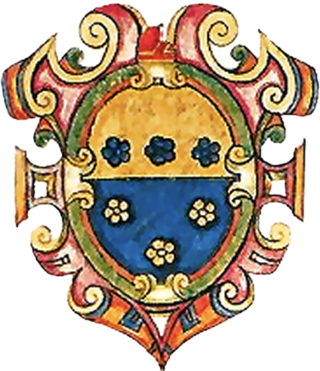
The House of Loredan-Santo Stefano was a cadet branch of the House of Loredan that existed from the 14th century until 1767. The branch was mainly settled in the Palazzo Loredan in Campo Santo Stefano, which they acquired in 1536 from the Mocenigo family. The progenitor of the branch is considered to be Gerolamo Loredan "dal Barbaro" di S. Vitale (d.~1474), father of Doge Leonardo Loredan and Dogaressa Caterina Loredan. Besides Leonardo, the branch also gave Doge Francesco Loredan.
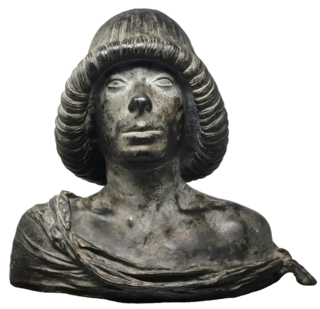
Andrea Loredan (1440–1513) was a Venetian nobleman of the Loredan family, known as a collector of art. He is notable for commissioning the Ca' Loredan Vendramin Calergi, a palace on the Grand Canal, to designs by Mauro Codussi. The palace was paid for by Doge Leonardo Loredan, it is known for its association with Richard Wagner and the palace today hosts the Casino of Venice. Andrea is also notable for paying for the choir of the church of San Michele in Isola, also designed by Codussi.
Caterina Loredan of the noble Loredan family was the Dogaressa of Venice from 1521 to 1523 by marriage to Doge Antonio Grimani.
Loredan is a Venetian surname. The House of Loredan is an aristocratic Venetian family that included various doges of the Republic of Venice, and the surname is almost exclusively associated with the family. The surname most likely originated from the toponym Loreo, which itself originated from its Latin name Lauretum, meaning laurel. Another theory of the origin of the surname, though most likely legendary, is that it comes from the Latin epithet Laureati, given to ancestors of the Loredan family due to their historical glory in ancient Rome and the many victories they achieved in battles. The surname is spelled Loredano or Loredan in Italian, Lauredano or Lauredanus in Latin, and Lorentano (Λορεντάνο) in Greek, though it is also historically found as Lordas (Λορδᾶς) and Lordano (Λορδάνο). The feminine name Loredana, common in Italy and Romania, was likely inspired by the surname.

The Portrait of Doge Leonardo Loredan is a painting by the Italian Renaissance master Vittore Carpaccio, a painter of the Venetian School and student of Gentile Bellini. The latter also painted a portrait of Doge Leonardo Loredan. It was most likely painted around 1501/02, at the beginning of Loredan's reign. The painting was restored in 2003 with funding from Mara and Chuck Robinson in honour of Prof. W. R. Rearick, and it is now displayed in the Museo Correr in Venice.

The Tomb of Doge Leonardo Loredan is a monumental 16th-century burial site located in the Basilica of Saints John and Paul in Venice, Italy. Interred in it are Leonardo Loredan, 75th Doge of Venice, and his descendant Francesco Loredan, 116th Doge of Venice, both members of the Santo Stefano branch of the House of Loredan.
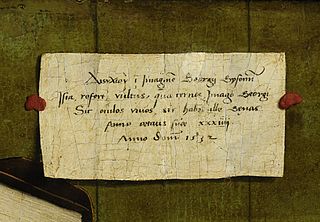
A cartellino is an illusionistic portrayal of a written note included in painting, mostly from the with a legend that records the name of the artist, the date, the subject, or some other relevant information about the work. About 500 Renaissance paintings include a cartellino, but the device has been adopted by some later artists.

The Portrait of the Doge Giovanni Mocenigo is a tempera-on-wood painting attributed to Italian artist Gentile Bellini, datable between 1478 and 1485. It is held at the Museo Correr, in Venice.
